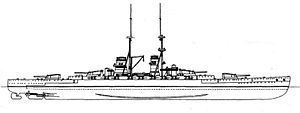Francesco Caracciolo-class battleship: Difference between revisions
Delink non-obscure units. Conversions. Report bugs to Lightmouse |
|||
| Line 58: | Line 58: | ||
[[Image:Italian battleship Francesco Caracciolo launching.jpg|300px|left|thumb|''Francesco Caracciolo'' is [[Ship naming and launching|launched]] at the Royal Naval Yard, Castellamare di Stabia, on 12 May 1920. She was the only ''Caracciolo''-class ship to be launched, but she was not completed.]] |
[[Image:Italian battleship Francesco Caracciolo launching.jpg|300px|left|thumb|''Francesco Caracciolo'' is [[Ship naming and launching|launched]] at the Royal Naval Yard, Castellamare di Stabia, on 12 May 1920. She was the only ''Caracciolo''-class ship to be launched, but she was not completed.]] |
||
The class was intended to carry eight 15-inch guns on a displacement of {{convert|32800|LT|t|abbr=on}}. Four oil-fired [[steam turbine]]s would propel them to {{convert|28|kn|km/h mph|lk=in|abbr=on}}, slightly faster than the British ''Queen Elizabeth''s which were themselves faster than most battleships. Armor — a {{convert|30|cm|in|abbr=on}} main belt, tapering to a {{convert|25|cm|in|abbr=on}} upper belt, with an additional {{convert|15|cm|in|abbr=on}} on the sides at the upper deck level around the secondary armament, a {{convert|3.5|cm|in|abbr=on}} armored deck and two torpedo bulkheads — was not much different from other ships of the same generation. |
The class was intended to carry eight 15-inch guns on a displacement of {{convert|32800|LT|t|abbr=on}}. Four oil-fired [[steam turbine]]s would propel them to {{convert|28|kn|km/h mph|lk=in|abbr=on}}, slightly faster than the British ''Queen Elizabeth''s which were themselves faster than most battleships at the time. Armor — a {{convert|30|cm|in|abbr=on}} main belt, tapering to a {{convert|25|cm|in|abbr=on}} upper belt, with an additional {{convert|15|cm|in|abbr=on}} on the sides at the upper deck level around the secondary armament, a {{convert|3.5|cm|in|abbr=on}} armored deck and two torpedo bulkheads — was not much different from other ships of the same generation. |
||
The initial secondary armament was eighteen 6-inch and twenty-four 3-inch guns, but the final design featured twelve 6-inch and an [[Anti-aircraft warfare|anti-aircraft armament]]. |
The initial secondary armament was eighteen 6-inch and twenty-four 3-inch guns, but the final design featured twelve 6-inch and an [[Anti-aircraft warfare|anti-aircraft armament]]. |
||
Revision as of 18:48, 15 September 2011
This article needs additional citations for verification. (August 2010) |

| |
| Class overview | |
|---|---|
| Operators | |
| Preceded by | Andrea Doria |
| Succeeded by | Littorio |
| Built | 1914–1920 |
| Planned | 4 |
| Completed | 0 |
| Cancelled | 4 |
| General characteristics | |
| Displacement | 34,000 long tons (35,000 t) |
| Length | 210 m (689 ft 0 in) |
| Beam | 29 m (95 ft 2 in) |
| Draft | 9.4 m (30 ft 10 in) |
| Installed power | 105,000 shp (78,000 kW) |
| Propulsion | list error: <br /> list (help) 4 × steam turbines 20 × boilers 4 × shafts |
| Speed | 28 kn (52 km/h; 32 mph) |
| Range | 6,000 nmi (11,000 km; 6,900 mi) at 10 kn (19 km/h; 12 mph) |
| Complement | 1,480 |
| Armament | list error: <br /> list (help) 8 × 380 mm (15 in) guns 12 × 150 mm (5.9 in) guns 12 × 40 mm (1.6 in) guns |
| Armor |
|
The Caracciolo class battleships were designed for the Italian Regia Marina in 1912-1913, and ordered in 1914, but never completed. The four ships of the class were intended to be the equivalent of the British Queen Elizabeth class and the answer to the Austro-Hungarian Ersatz Monarch class.
Design

The class was intended to carry eight 15-inch guns on a displacement of 32,800 long tons (33,300 t). Four oil-fired steam turbines would propel them to 28 kn (52 km/h; 32 mph), slightly faster than the British Queen Elizabeths which were themselves faster than most battleships at the time. Armor — a 30 cm (12 in) main belt, tapering to a 25 cm (9.8 in) upper belt, with an additional 15 cm (5.9 in) on the sides at the upper deck level around the secondary armament, a 3.5 cm (1.4 in) armored deck and two torpedo bulkheads — was not much different from other ships of the same generation.
The initial secondary armament was eighteen 6-inch and twenty-four 3-inch guns, but the final design featured twelve 6-inch and an anti-aircraft armament.
Fate
All four ships were laid down between October 1914 and June 1915. Work was suspended in 1916, by which stage only the first ship — Francesco Caracciolo — had significant work completed. She was restarted in 1919 and launched in 1920 to clear the slipway she was built on. A plan to convert her to an aircraft carrier was considered and rejected, as the Regia Marina had no interest in carriers. The other three ships were cancelled and dismantled. The heavy guns intended for the class were assigned to monitors.
The hull of Francesco Caracciolo was sold after launching to Navagazione Generale Italiana in October 1920, who intended to turn her into a merchant ship, but this work was cancelled.
Ships
- Francesco Caracciolo: laid down 12 October 1914, launched 12 May 1920 - Royal Naval Yard, Castellamare di Stabia
- Francesco Morosini: laid down 27 June 1915 - Orlando, Livorno
- Cristoforo Colombo: laid down 14 March 1915 - Ansaldo, Genoa
- Marcantonio Colonna: laid down 3 March 1915 - Odero, Sestri Ponente
Sources
- Breyer, S. Battleships and Battlecruisers of the World, London, Macdonald 1973
- Faccaroli, Aldo (1970). Italian Warships of World War I. London: Ian Allan. ISBN 0-7110-010-5.
{{cite book}}: Check|isbn=value: length (help)
